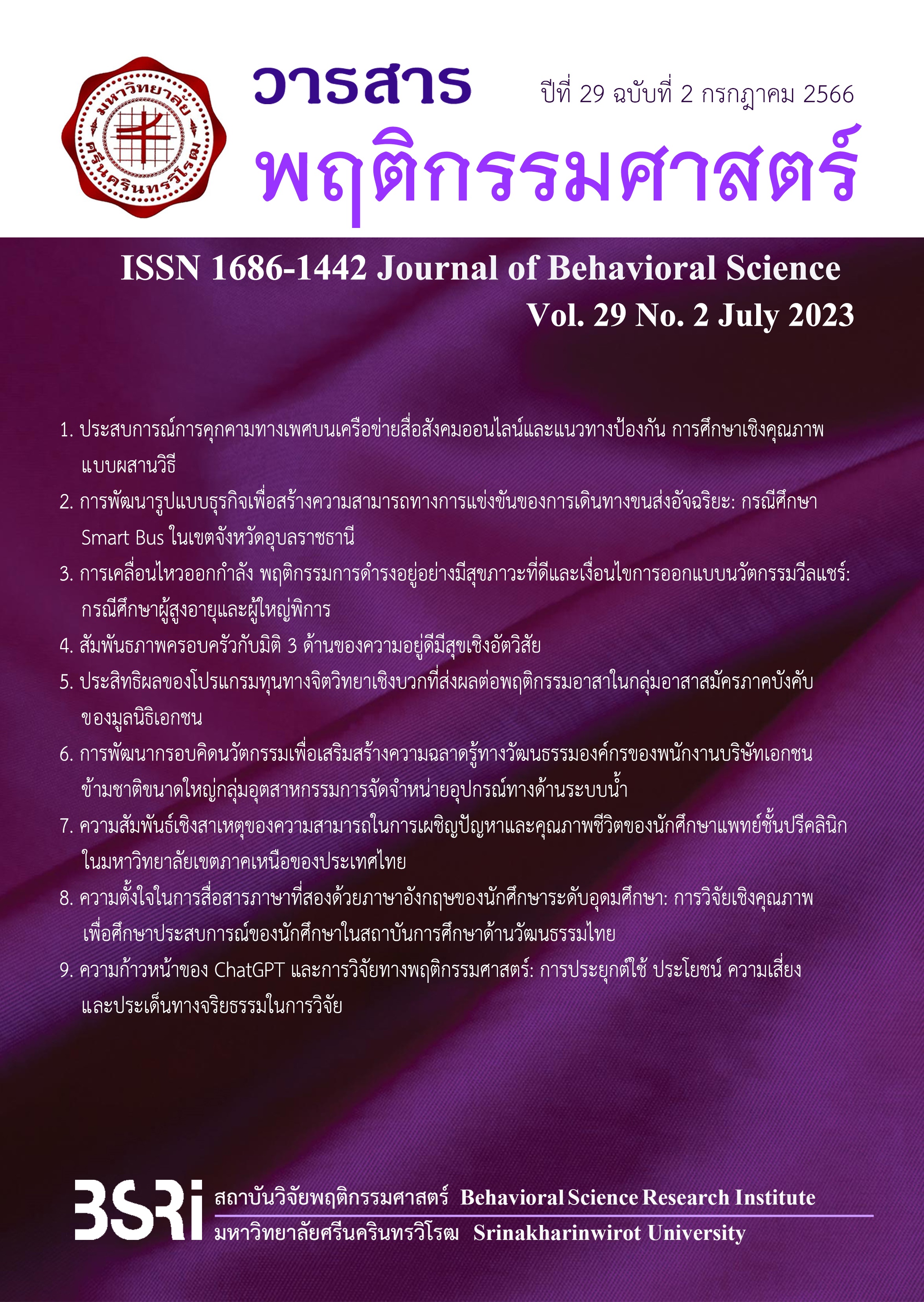ความตั้งใจในการสื่อสารภาษาที่สองด้วยภาษาอังกฤษของนักศึกษาระดับอุดมศึกษา: การวิจัยเชิงคุณภาพเพื่อศึกษาประสบการณ์ของนักศึกษาในสถาบันการศึกษาด้านวัฒนธรรมไทย
คำสำคัญ:
ความตั้งใจในการสื่อสารในภาษาที่สอง, พฤติกรรมการเรียนรู้ภาษาอังกฤษด้วยการนำตนเอง, ระดับอุดมศึกษา, การวิจัยเชิงคุณภาพ, ทฤษฎีการกำหนดตนเอง, แนวคิดทางพุทธศาสตร์บทคัดย่อ
การวิจัยเชิงคุณภาพนี้มีวัตถุประสงค์เพื่อศึกษาคุณลักษณะของปัจจัยที่ส่งเสริมหรือลดความตั้งใจและสังเคราะห์รูปแบบความสัมพันธ์ของปัจจัยที่ส่งเสริมความตั้งใจในการสื่อสารภาษาอังกฤษ ผ่านการบูรณาการแนวคิดความตั้งใจในการสื่อสารภาษาที่สอง ทฤษฎีการกำหนดตนเองและแนวคิดฉันทะเพื่อเป็นแนวทางในการศึกษา ดำเนินการศึกษาด้วยรูปแบบการสัมภาษณ์เชิงลึกกับกลุ่มตัวอย่างซึ่งคัดเลือกแบบเฉพาะเจาะจงโดยเป็นนักศึกษาระดับปริญญาตรีชั้นปีที่ 2 ในสถาบันอุดมศึกษาแห่งหนึ่ง จำนวน 20 คน ด้วยชุดคำถามสัมภาษณ์แบบกึ่งโครงสร้างที่ตรวจสอบโดยผู้เชี่ยวชาญ ตรวจสอบเนื้อหาโดยผู้ให้ข้อมูลตรวจทานด้วยตนเองหลังเสร็จสิ้นการสัมภาษณ์ ผู้วิจัยใช้การวิเคราะห์เนื้อหาเป็นแนวทางการวิเคราะห์ข้อมูล ผลการศึกษาพบว่า 1)คุณลักษณะของความตั้งใจในการสื่อสารภาษาที่สองด้วยภาษาอังกฤษของผู้ให้ข้อมูลมีลักษณะที่เป็นเหตุและผล โดยเหตุได้แก่ ความอยาก ความชอบ เป้าหมายในภาษาอังกฤษ และผลได้แก่ การทุ่มสุดตัว ความเต็มที่กับการเรียนรู้ ซึ่งผลลัพธ์นั้นสามารถกลับไปกระตุ้นคุณลักษณะที่เป็นเหตุได้ โดยคุณลักษณะดังกล่าวสามารถจัดกลุ่มเป็นปัจจัยทางจิตวิทยาที่ส่งผลเพิ่มหรือลดความตั้งใจ 3 ด้าน ได้แก่ ด้านความรู้สึก ด้านความคิด และด้านแรงจูงใจ 2)ปัจจัยทางจิตวิทยาที่ส่งผลเพิ่มหรือลดความตั้งใจสามารถส่งผลต่อการเพิ่มขึ้นหรือลดลงของปัจจัยตามทฤษฎีการกำหนดตนเองและแนวคิดฉันทะ อันนำไปสู่การส่งผลต่อการเพิ่มหรือลดความตั้งใจในการสื่อสารภาษาที่สองด้วยภาษาอังกฤษในที่สุด 3)รูปแบบพื้นฐานของทฤษฎีการกำหนดตนเองสอดคล้องกับแนวคิดฉันทะ โดยมีบางส่วนที่สะท้อนความแตกต่างทางวัฒนธรรมเชิงปัจเจกและสังคมรวมกลุ่ม ข้อเสนอแนะที่ได้คือการพัฒนาแนวทางการเรียนรู้ด้วยหลักจิตวิทยาการเรียนรู้ผ่านการบูรณาการทฤษฎีและแนวคิดเพื่อส่งเสริมความตั้งใจในการสื่อสารภาษาที่สองด้วยภาษาอังกฤษด้วยการวิจัยผสานวิธีเพื่อให้ได้แนวทางที่มีประสิทธิภาพด้วยความเข้าใจต่อบริบทของระบบการศึกษาไทยต่อไป
Downloads
เอกสารอ้างอิง
Ayres, L., & Knafle, K. A. (2008). Typological Analysis. In L. M. Given (Ed.), Sage encyclopedia of qulitative research methods. Sage.
Bandura, A. (1986). Social Foundations of Thought and Action: A Social Cognitive Theory. Prentice-Hall.
Birt, L., Scott, S., Cavers, D., Campbell, C., & Walter, F. (2016). Member Checking: A Tool to Enhance Trustworthiness or Merely a Nod to Validation? Qualitative Health Research, 26(13), 1802-1811. doi:10.1177/1049732316654870
Boonsathirakul, J., & Somanandana, V. (2019). Development of the Excellent Achievement Motivation Test Based on Buddhism for Undergraduate Students. Journal of Education, Mahasarakham University, 13(3), 41-52. http://edu.msu.ac.th/journal/home/journal_file/612.pdf
Cadet, J. M. (1971). The Ramakien: The Thai Epic. Kodansha International.
Central Intelligence Agency. (2021). Field Listing-Language. https://www.cia.gov/the-world-factbook/field/languages/.
Creswell, J. W., & Clark, V. L. P. (2017). Designing and Conducting Mixed Methods Research. SAGE.
Dincer, A., & Yesilyurt, S. (2017). Motivation to Speak English: A Self-Determination Theory Perspective. PASAA: Journal of Language Teaching and Learning in Thailand, 53, 1-25.
Eddy-U, M. (2015). Motivation for participation or non-participation in group tasks: A dynamic systems model of task-situated willingness to communicate. System, 50, 43-55.
EnglishFirstEducation. (2019). EF English Proficiency Index – A Comprehensive Ranking of Countries by English Skills [online]. https://www.ef.com/__/~/media/centralefcom/epi/downloads/full-reports/v9/ef-epi-2019-english.pdf
Fishbein, M., & Ajzen, I. (2011). Predicting and Changing Behavior: The Reasoned Action Approach. Taylor & Francis.
Fredricks, J. A., Blumenfeld, P. C., & Paris, A. H. (2004). School Engagement: Potential of the Concept, State of the Evidence. Review of Educational Research, 74, 59-109. doi:10.3102/00346543074001059
Gross, M. (2017). Planned Behavior: The Relationship between Human Thought and Action. Taylor & Francis.
Hashimoto, Y. (2002). Motivation and willingness to communicate as predictors of reported L2 use. The Japanese ESL context. Second language studies, 20(2), 29-70.
Heine, S. J., & Lehman, D. R. (1997). Culture, dissonance, and self-affirmation. Personality and Social Psychology Bulletin, 23, 389-400. doi:10.1177/0146167297234005
Hwang, K.-K., & Hwang, K.-K. (2012). Face and morality in Confucian society. Foundations of Chinese psychology, Confucian social relations, 1, 265-295.
Johnson, R., & Turner, L. (2003). Data collection strategies in mixed methods research. Sage.
Johnson, W. B., & Kaslow, N. J. (2014). The Oxford Handbook of Education and Training in Professional Psychology. Oxford University Press.
Lama, T. D., Cutler, H. C., & Cutler, H. (1999). The Art of Happiness: A Handbook for Living. Hodder & Stoughton.
MacIntyre, P. D. (2007). Willingness to communicate in the second language: Understanding the decision to speak as a volitional process. The modern language journal, 91(4), 564-576.
MacIntyre, P. D., Clément, R., Dörnyei, Z., & Noels, K. A. (1998). Conceptualizing willingness to communicate in a L2: A situational model of L2 confidence and affiliation. The modern language journal, 82(4), 545-562.
Melchert, T. P. (2011). Foundations of Professional Psychology: The End of Theoretical Orientations and the Emergence of the Biopsychosocial Approach. Elsevier Science.
Napak-on, S. (2021). English O-NET and the core curriculum: Expectations and alignments. Rangsit Journal of Educational Studies, 8(1), 26-45. https://rsujournals.rsu.ac.th/index.php/RJES/article/view/2128/1840
Niemiec, C. P., & Ryan, R. M. (2009). Autonomy, competence, and relatedness in the classroom: Applying self-determination theory to educational practice. Theory and research in Education, 7(2), 133-144.
Office of Contemporary Art and Culture. (2020). Strategic Plan for Contemporary Art and Culture 2020 - 2022.
Pattapong, K. (2010). Willingness to communicate in a second language: A qualitative study of issues affecting Thai EFL learners from students' and teachers' point of view [Doctoral dissertation]. University of Sydney.
Payutto, B. P. A. (2007). Vision of the Dhamma: A Collection of Buddhist Writings in English. Wat Nyanavesakavan.
Payutto, B. P. A. (2021). Buddhadhamma: The Laws of Nature and Their Benefits to Life: Buddhadhama Foundation.
Roorda, D., Koomen, H., Spilt, J., & Oort, F. (2011). The Influence of Affective Teacher-Student Relationships on Students' School Engagement and Achievement: A Meta-Analytic Approach. Review of Educational Research, 81, 493-529. doi:10.3102/0034654311421793
Ryan, R. M., & Deci, E. L. (2018). Self-Determination Theory: Basic Psychological Needs in Motivation, Development, and Wellness. Guilford Publications.
Schwab, K., & Zahidi, S. (2020). Global competitiveness report: special edition 2020.
Somanandana, V., & Yamwong, P. (2019). The Effect of Buddhist Group Counseling to Develop the Excellent Achievement Motivation for Undergraduate Students]. Journal of Education Studies, Chulalongkorn University, 47(4), 445-464. https://digital.car.chula.ac.th/educujournal/vol47/iss4/24/
Suebdoung, M. (2007). Man's Motivation from The Buddhist Perspective. Journal of Liberal Arts, Thammasat University, 7(2), 101-129. https://so03.tci-thaijo.org/index.php/liberalarts/article/view/13353/12009
Szmigiera, M. (2021). The most spoken languages worldwide 2021. https://www.statista.com/statistics/266808/the-most-spoken-languages-worldwide/
The National Institute of Educational Testing Service. (2021). O-Net: Ordinary National Educational Test. https://catalog.niets.or.th/group/1education
Yashima, T. (2002). Willingness to Communicate in a Second Language: The Japanese EFL Context. The modern language journal, 86, 54-66. doi:10.1111/1540-4781.00136
ดาวน์โหลด
เผยแพร่แล้ว
รูปแบบการอ้างอิง
ฉบับ
ประเภทบทความ
สัญญาอนุญาต
ลิขสิทธิ์ (c) 2023 วารสารพฤติกรรมศาสตร์

อนุญาตภายใต้เงื่อนไข Creative Commons Attribution-NonCommercial-NoDerivatives 4.0 International License.
สถาบันวิจัยพฤติกรรมศาสตร์ มหาวิทยาลัยศรีนครินทรวิโรฒ
114 ซอยสุขุมวิท 23 ถนนสุขุมวิท แขวงคลองเตยเหนือ เขตวัฒนา กรุงเทพฯ 10110
โทร 02-649-5000 ต่อ 17600



